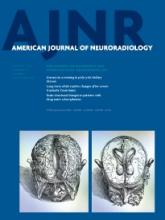Research ArticleBrain
Open Access
Long-Term White Matter Changes after Severe Traumatic Brain Injury: A 5-Year Prospective Cohort
J. Dinkel, A. Drier, O. Khalilzadeh, V. Perlbarg, V. Czernecki, R. Gupta, F. Gomas, P. Sanchez, D. Dormont, D. Galanaud, R.D. Stevens, L. Puybasset and for NICER (Neuro Imaging for Coma Emergence and Recovery) Consortium
American Journal of Neuroradiology January 2014, 35 (1) 23-29; DOI: https://doi.org/10.3174/ajnr.A3616
J. Dinkel
aFrom the Department of Radiology (J.D., O.K., R.G.), Massachusetts General Hospital, Harvard Medical School, Boston, Massachusetts
bDepartment of Radiology (J.D.), University Hospital Heidelberg, Heidelberg, Germany
A. Drier
cDepartments of Neuroradiology (A.D., D.D., D.G.)
O. Khalilzadeh
aFrom the Department of Radiology (J.D., O.K., R.G.), Massachusetts General Hospital, Harvard Medical School, Boston, Massachusetts
V. Perlbarg
fINSERM, UMRS 678 (V.P.)
V. Czernecki
dNeurology (V.C.)
gINSERM, CRICM UMR S975 (V.C.), Université Pierre et Marie Curie-Paris 6, Paris, France
R. Gupta
aFrom the Department of Radiology (J.D., O.K., R.G.), Massachusetts General Hospital, Harvard Medical School, Boston, Massachusetts
F. Gomas
hDepartment of Anesthesiology and Intensive Care (F.G.), Louis Mourier Hospital, Colombes, France
P. Sanchez
eAnesthesiology and Intensive Care (P.S., L.P.), Pitié Salpêtrière Hospital, Assistance Publique–Hôpitaux de Paris, France
D. Dormont
cDepartments of Neuroradiology (A.D., D.D., D.G.)
D. Galanaud
cDepartments of Neuroradiology (A.D., D.D., D.G.)
R.D. Stevens
iDivision of Neuroscience Critical Care (R.D.S.), Department of Anesthesiology Critical Care Medicine, Johns Hopkins University School of Medicine, Baltimore, Maryland.
L. Puybasset
eAnesthesiology and Intensive Care (P.S., L.P.), Pitié Salpêtrière Hospital, Assistance Publique–Hôpitaux de Paris, France

REFERENCES
- 1.↵
- Saatman KE,
- Duhaime AC,
- Bullock R,
- et al
- 2.↵
- Narayan RK,
- Michel ME,
- Ansell B,
- et al
- 3.↵
- Smith DH,
- Meaney DF,
- Shull WH
- 4.↵
- Wada T,
- Asano Y,
- Shinoda J
- 5.↵
- Basser PJ,
- Mattiello J,
- LeBihan D
- 6.↵
- Kraus MF,
- Susmaras T,
- Caughlin BP,
- et al
- 7.↵
- Kumar R,
- Husain M,
- Gupta RK,
- et al
- 8.↵
- Ewing-Cobbs L,
- Prasad MR,
- Swank P,
- et al
- 9.↵
- Akpinar E,
- Koroglu M,
- Ptak T
- 10.↵
- Wilde EA,
- Chu Z,
- Bigler ED,
- et al
- 11.↵
- Wilde EA,
- McCauley SR,
- Hunter JV,
- et al
- 12.↵
- 13.↵
- 14.↵
- 15.↵
- Yuan W,
- Holland SK,
- Schmithorst VJ,
- et al
- 16.↵
- Levin HS
- 17.↵
- Wu TC,
- Wilde EA,
- Bigler ED,
- et al
- 18.↵
- 19.↵
- 20.↵
- Smith SM,
- Jenkinson M,
- Woolrich MW,
- et al
- 21.↵
- Pierpaoli C,
- Basser PJ
- 22.↵
- Smith SM,
- Jenkinson M,
- Johansen-Berg H,
- et al
- 23.↵
- Mori S,
- Wakana S,
- Nagae-Poetscher L,
- et al
- 24.↵
- 25.↵
- Benjamini Y,
- Hochberg Y
- 26.↵
- Sidaros A,
- Engberg AW,
- Sidaros K,
- et al
- 27.↵
- Mac Donald CL,
- Dikranian K,
- Bayly P,
- et al
- 28.↵
- Huisman TA,
- Schwamm LH,
- Schaefer PW,
- et al
- 29.↵
- Farbota KD,
- Bendlin BB,
- Alexander AL,
- et al
- 30.↵
- Parvizi J,
- Damasio AR
In this issue
American Journal of Neuroradiology
Vol. 35, Issue 1
1 Jan 2014
Advertisement
J. Dinkel, A. Drier, O. Khalilzadeh, V. Perlbarg, V. Czernecki, R. Gupta, F. Gomas, P. Sanchez, D. Dormont, D. Galanaud, R.D. Stevens, L. Puybasset, for NICER (Neuro Imaging for Coma Emergence and Recovery) Consortium
Long-Term White Matter Changes after Severe Traumatic Brain Injury: A 5-Year Prospective Cohort
American Journal of Neuroradiology Jan 2014, 35 (1) 23-29; DOI: 10.3174/ajnr.A3616
0 Responses
Long-Term White Matter Changes after Severe Traumatic Brain Injury: A 5-Year Prospective Cohort
J. Dinkel, A. Drier, O. Khalilzadeh, V. Perlbarg, V. Czernecki, R. Gupta, F. Gomas, P. Sanchez, D. Dormont, D. Galanaud, R.D. Stevens, L. Puybasset, for NICER (Neuro Imaging for Coma Emergence and Recovery) Consortium
American Journal of Neuroradiology Jan 2014, 35 (1) 23-29; DOI: 10.3174/ajnr.A3616
Jump to section
Related Articles
- No related articles found.
Cited By...
This article has not yet been cited by articles in journals that are participating in Crossref Cited-by Linking.
More in this TOC Section
Similar Articles
Advertisement











